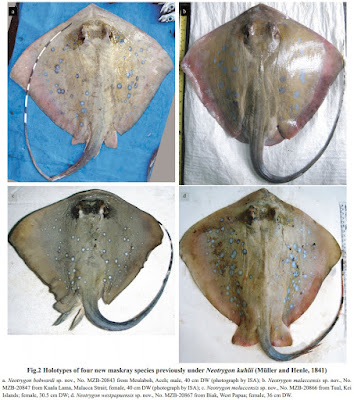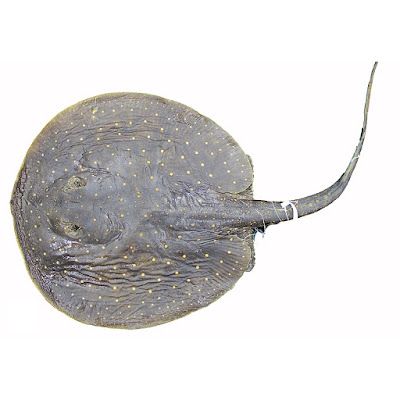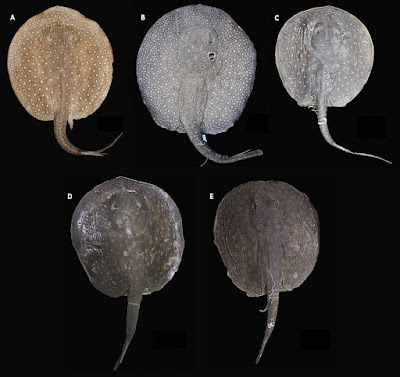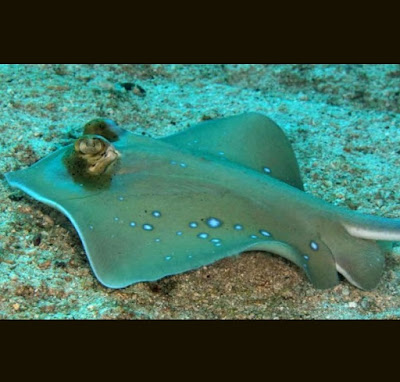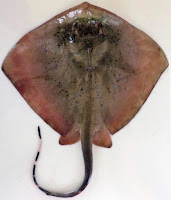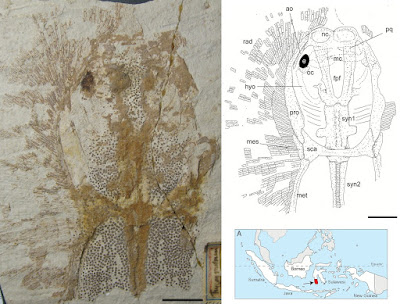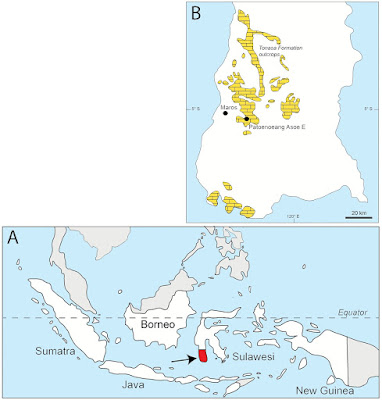Abstract
Nine morphologically similar but genetically distinct lineages in the blue-spotted maskray species complex, previously Neotrygon kuhlii (Müller and Henle) qualify as cryptic species. Four of these lineages have been previously described as Neotrygon australiae Last, White and Séret, Neotrygon caeruleopunctata Last, White and Séret, Neotrygon orientale Last, White and Séret, and Neotrygon varidens (Garman), but the morphological characters used in the descriptions off ered poor diagnoses and their geographic distributions were not delineated precisely. The objective of the present work is to complete the description of the cryptic species in the complex. Here, an additional four lineages are described as new species on the basis of their mitochondrial DNA sequences: Neotrygon bobwardi, whose distribution extends from the northern tip of Aceh to the western coast of Sumatera; Neotrygon malaccensis, sampled from the eastern part of the Andaman Sea and from the Malacca Strait; Neotrygon moluccensis, from the eastern half of the Banda Sea; and Neotrygon westpapuensis from the central portion of northern West Papua. The geographic distributions of N. australiae, N. coeruleopunctata, N. orientale, and N. varidens are updated. For each species, a diagnosis is provided in the form of a combination of private or partly-private nucleotides at 2–4 nucleotide sites along a 519-base pair fragment of the CO1 gene. We believe that the present taxonomic revision will provide information relevant to the sound management and conservation of cryptic species of the blue-spotted maskray in the Coral Triangle region.
Keyword : molecular taxonomy; diagnosis; distribution
Neotrygon bobwardi sp. nov.
Clade II (Borsa et al., 2016b);
Neotrygon kuhlii clade II (Arlyza et al., 2013a; Borsa et al., 2016a);
Neotrygon kuhlii (Borsa et al., 2013a).
Neotrygon kuhlii clade II (Arlyza et al., 2013a; Borsa et al., 2016a);
Neotrygon kuhlii (Borsa et al., 2013a).
Distribution: the type locality of N. bobwardi sp. nov. is Meulaboh, northwestern coast of Sumatra Island. Based on present study, its distribution includes the northern tip of the Aceh region and all the western coast of Sumatra south to Padang.
Etymology: the species is named after Robert D. (Bob) Ward, one of the leaders of the fi sh barcoding initiative (Ward et al., 2009). One of his noted contributions in this fi eld was the DNA-barcoding survey of Australian chondrichthyans, which included bluespotted maskray samples from the Coral Triangle region (Ward et al., 2008). R. D. Ward and co-authors suspected the occurrence of cryptic species within the nominal species N. kuhlii, based on an unusually high level of genetic divergence among geographic populations, at the CO1 locus. We chose to name after him the bluespotted maskray species that occurs on the Indian-Ocean coast of Sumatra, as an acknowledgement of his contribution to the systematics of chondrichthyans.
Proposed vernacular names: Bob Ward’s bluespotted maskray (English); pari masker totol biru Pak Bob (Indonesian); raie pastenague à points bleus de Bob Ward (French).
Neotrygon malaccensis sp. nov.
Clade III (Borsa et al., 2016b);
Neotrygon kuhlii clade III (Arlyza et al., 2013a; Borsa et al., 2016a);
Neotrygon kuhlii clade 7 (Puckridge et al., 2013);
Neotrygon kuhlii (Borsa et al., 2013a).
Neotrygon kuhlii clade III (Arlyza et al., 2013a; Borsa et al., 2016a);
Neotrygon kuhlii clade 7 (Puckridge et al., 2013);
Neotrygon kuhlii (Borsa et al., 2013a).
Distribution: the type locality of N. malaccensis sp. nov. is Kuala Lama, Malacca Strait (03°39′N, 98°59′E). Specimens of the same species were sampled from Perbaungan, a neighbouring locality in the Malacca Strait and from the western coast of the Kra isthmus, Thailand. Known distribution, based on present study: northern part of Malacca Strait and eastern Andaman Sea.
Etymology: epithet malaccensis refers to the geographic origin of the type material, the Malacca Strait. It is the latinized geographical adjectival form of noun “Malacca”.
Proposed vernacular names: the Malacca Strait bluespotted maskray (English); pari masker totol biru Selat Melaka (Indonesian); raie pastenague masquée à points bleus du détroit de Malacca (French).
Neotrygon moluccensis sp. nov.
Clade VII (Borsa et al., 2016b);
Neotrygon kuhlii Clade VII (Arlyza et al., 2013a; Borsa et al., 2016a);
Neotrygon kuhlii (Borsa et al., 2013a).
Neotrygon kuhlii Clade VII (Arlyza et al., 2013a; Borsa et al., 2016a);
Neotrygon kuhlii (Borsa et al., 2013a).
Distribution: the type locality of N. moluccensis sp. nov. is Tual, Kei Islands, Moluccas, Indonesia. Specimens of the same species were sampled from Ambon, Moluccas. Known distribution, based on present study: eastern half of Banda Sea.
Etymology: epithet moluccensis refers to the geographic origin of the type material, the Molucca islands. It is the latinized geographical adjectival form of noun “Molucca”.
Proposed vernacular names: Moluccan bluespotted maskray (English); pari masker totol biru Maluku (Indonesian); raie pastenague masquée à points bleus des Moluques (French).
Neotrygon westpapuensis sp. nov.
Clade VIII (Borsa et al., 2016b);
Neotrygon kuhlii clade VIII (Arlyza et al., 2013a; Borsa et al., 2016a);
Neotrygon kuhlii (Borsa et al., 2013a).
Neotrygon kuhlii clade VIII (Arlyza et al., 2013a; Borsa et al., 2016a);
Neotrygon kuhlii (Borsa et al., 2013a).
Distribution: the type locality of N. westpapuensis sp. nov. is Biak Island north of Cenderawasih Bay, West Papua. As all samples we have of this species originate from Biak and from nearby Numfor Island only, amid a wide unsampled region (Fig.1a), no distribution map can be inferred at present. The geological features of the northern coastline of the Vogelkop peninsula, where the shallow-water habitat favourable to blue-spotted maskrays is absent, isolate the reef fauna of Cenderawasih Bay from that of western West Papua further west. Further research is needed to delineate the precise geographic distribution of N. westpapuensis sp. nov.
Etymology: Named for the country of type locality, West Papua as it is spelled since 1961 (Saltford, 2003). Epithet westpapuensis is the latinized geographical adjectival form of noun “West Papua”, with no emendation.
Proposed vernacular names: West Papuan bluespotted maskray (English); pari masker totol biru West Papua (Indonesian); raie pastenague masquée à points bleus de Papouasie Occidentale (French).
Philippe Borsa, Irma S. Arlyza, Thierry B. Hoareau and Kang-Ning Shen. 2017. Diagnostic Description and Geographic Distribution of Four New Cryptic Species of the Blue-spotted Maskray Species Complex (Myliobatoidei: Dasyatidae; Neotrygon spp.) based on DNA Sequences. Chinese Journal of Oceanology and Limnology. DOI: 10.1007/s00343-018-7056-2
---------------------------------------------------------------
روابط التحميل والمشاهدة، الروابط المباشرة للتحميل
او
شاهد هذا الفيديو القصير لطريقة التحميل البسيطة
كيف تحصل على مدونة جاهزة بآلاف المواضيع والمشاركات من هنا
شاهد قناة منتدى مدونات بلوجر جاهزة بألاف المواضيع والمشاركات على اليوتيوب لمزيد من الشرح من هنا
رابط مدونة منتدى مدونات بلوجر جاهزة بآلاف المواضيع والمشاركات في أي وقت حــــتى لو تم حذفها من هنا
شاهد صفحة منتدى مدونات بلوجر جاهزة بألاف المواضيع والمشاركات على الفيس بوك لمزيد من الشرح من هنا
شاهد صفحة منتدى مدونات بلوجر جاهزة بألاف المواضيع والمشاركات على الفيس بوك لمزيد من الشرح من هنا
تعرف على ترتيب مواضيع منتدى مدونات بلوجر جاهزة بآلاف المواضيع والمشاركات (حتى لا تختلط عليك الامور) من هنا
ملاحظة هامة: كل عمليات تنزيل، رفع، وتعديل المواضيع الجاهزة تتم بطريقة آلية، ونعتذر عن اي موضوع مخالف او مخل بالحياء مرفوع بالمدونات الجاهزة بآلاف المواضيع والمشاركات، ولكم ان تقوموا بحذف هذه المواضيع والمشاركات والطريقة بسيطة وسهلة. ــــــــــــــــــــــــــــــــــــــــــــــــــــــــــــــــــــــــــــــسلامـ.



